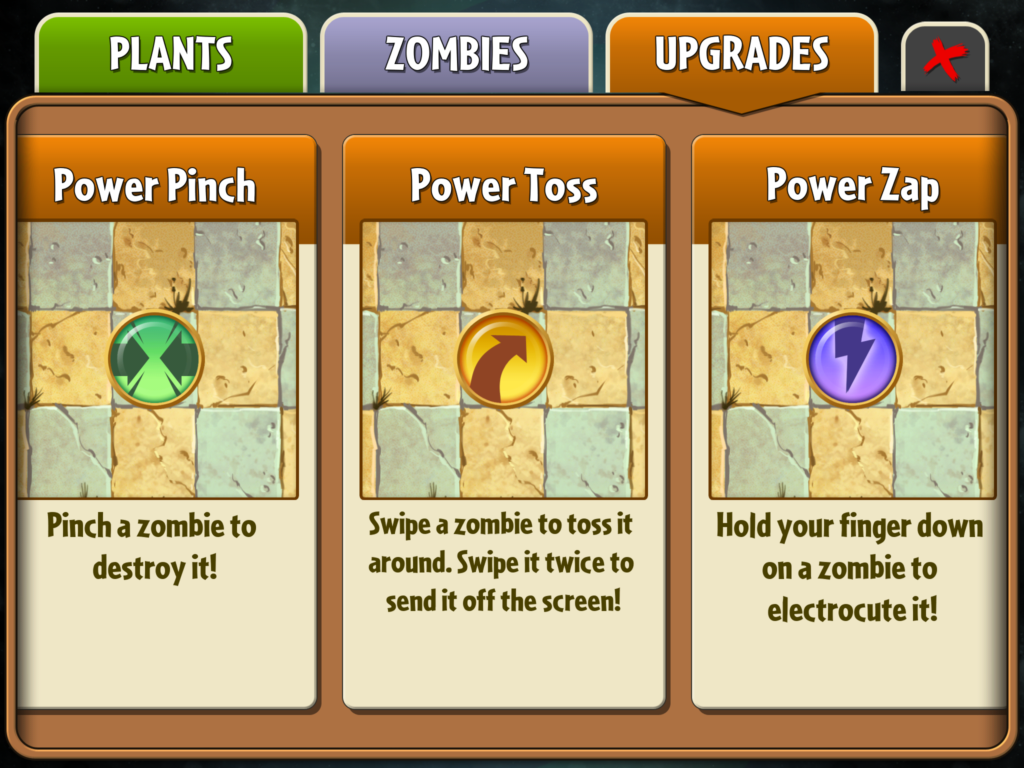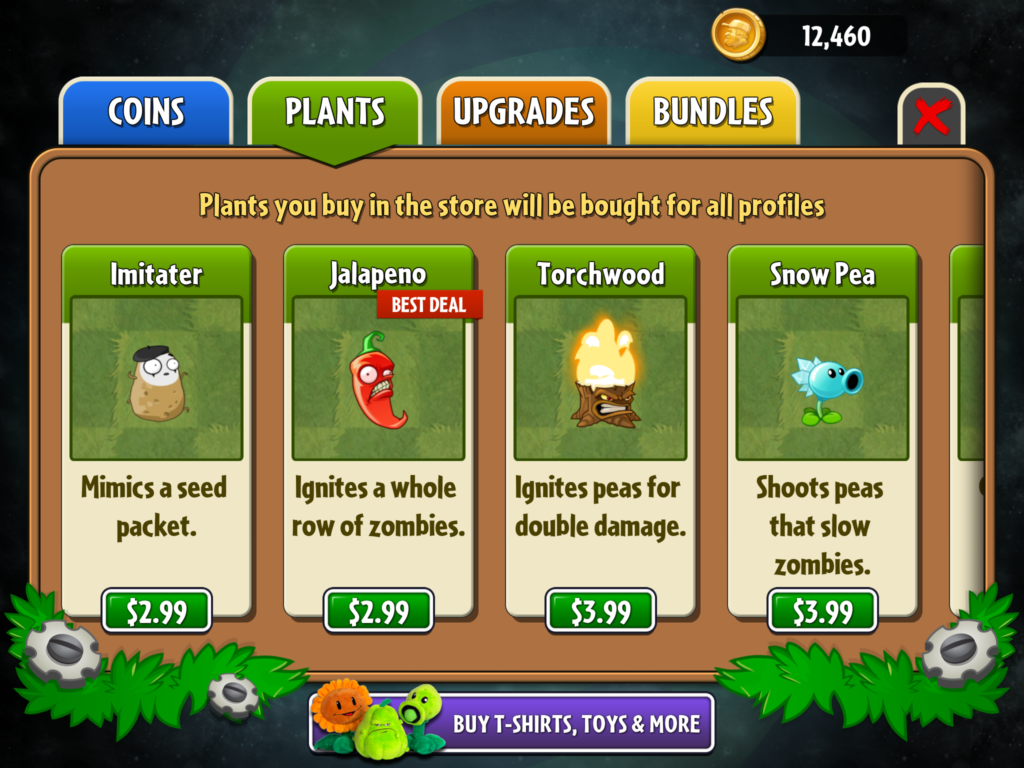Plants vs. Zombies 2 is the most fun I’ve had with a tablet game in a long time. It improves on the original in a lot of new, innovative ways. Too bad the distribution model and price point ($0 + a million possible not-so-micro-transactions) are totally stupid, turning an incredibly fun game into a tedious mess.
The subtitle of Plants vs Zombies 2 is “It’s About Time.” Indeed, PvZ, it is. The original was released in May of 2009. It was purchased in June of 2009 in the Citizen-Bot household as a gift for Citizen-Bot’s wife, who was a huge fan of other games from PopCap, such as Dynomite, Zuma, Bejeweled, and Bookworm Adventures, but was not so much a fan of zombies. In the last 4 years I still haven’t convinced her to watch The Walking Dead with me, but we’ve bought Plants vs. Zombies at least 4 different times on different platforms, including the “Game of the Year” Edition which replaced the Michael Jackson zombies with disco zombies. We also bought the Plants vs Zombies deck in Zen Pinball and play that pretty regularly. The kids love the game, too, including watching PvZ videos on youtube ad nauseam. So there’s a lot of love in my house for this franchise.
And so the sequel lives up to those expectations in many ways. The “plot,” as it were, is that your neighbor Crazy Dave eats a taco. And because it was so good, he decides to go back in time to eat it again because of course. And so you go back in time with Dave and his time machine Penny (a converted RV) and end up in Ancient Egypt. Instead of just zombies, now they’re mummies you have to deal with, including “Ra zombies” who steal your sunshine (and say “Ra!” a lot), mummies who hide behind murals of camels (instead of screen doors, like the original), and so on.
And your arsenal gets expanded, too. You get a boomerang throwing plant who hits targets both coming and going, and my new favorite, the Bonk Choy– a bok choy which smacks targets both behind and in front of him. There are also all sorts of power-ups. Some of the power-ups allow you to pinch the zombies and kill them, or zap them, or flick them off the screen. You can also collect plant food, which powers up a plant temporarily, so a pea shooter turns into a pea-howitzer for a moment.
As you progress through the game, you also collect keys, which allow you to open gates to side-quests, wherein you can unlock other plants, special power-ups, and so on. Along with Ancient Egypt, there is also the Pirate Seas and the Wild West, but (and herein begins one of my first complaints with the game), upon beating the final level of Egypt, you are blocked from moving forward.
Instead you are told you have to unlock a stargate by going back and collecting stars in each of the levels you’ve just beaten. And how do you get stars? Why, by beating the level with a specific set of parameters. Don’t let the zombies “trample the flowers” (cross a simple line of flowers in the middle of the board), only use x plants, don’t lose any more than x plants, don’t spend more than x sun, etc. And herein lies the tedium.
Instead of just letting you beat this tower defense game with your own strategy and play style, you have to conform to a different set of rules. I understand that there is a challenge there, and for some that might be fun. But when you are stuck unless you beat the same level over and over and over. . .that is the very definition of tedium.
Oh, but you can speed things up. But only if you are willing to shell out money to EA for “microtransactions” that aren’t so micro and quickly add up. Want to have an extra seed slot? That’ll be $3.99.
Old friends like Jalapeno, Snow Pea, Torchwood, and Imitator? That’ll be $14 for those four plants. Oh, and don’t worry, there’s more to buy, too:
At every turn there is an attempt to nickel and dime you out of some money in order to play the game. Want to play all of the levels in Ancient Egypt? Sorry, half of them are behind locked doors, along with some plants and powerups. And if you want to collect keys to open them, you have to play and replay the levels to randomly find keys, or pay some money for them. So, let me say this very clearly: the game itself is pretty fun. The way they are trying to make money off of it is balls.
I blame Electronic Arts. I know, I know, it’s almost a cliche to hate EA at this point. But this has been a big deal: EA bought PopCap and this is part of what has delayed the development of PvZ 2, because EA expects to make their money back and turn this into a cash cow. And reading the comments on the iTunes store (because this is available exclusively for iOS users, natch– because screw you, the majority of people on PCs and Android devices) the hate is strong for EA.
But I’m going to do something different and defend EA. I am going to lambaste them for the how they are handling PvZ 2, but compare them to other games that they own with successful, and better, models for monetizing a game.
First, SimCity, and the Sims franchise in general: You buy the game outright first. And then you can pay for extra premium content later. But you get the whole game first.
Second, Star Wars: The Old Republic. The game itself is free to play. But if you want to level up faster, and get extra collectible gear and cool add-ons, you can either purchase them directly, or through a subscription you can earn them that way.
Third, The Simpsons: Tapped Out. This game is super fun even if you put zero dollars into it. Yes, you can get tons more cool stuff if you want to pay for it. But whether or not you have Duffman or Hank Scorpio and his Volcano Lair (who all cost donuts, which are mostly available only as premium currency which you purchase for cash) doesn’t prevent you from progressing in the game.
All three of those are EA games. But somehow, EA managed to totally screw this one up. It’s like they looked at the teeming masses of idiots who played Farmville and are now playing Candy Crush and said, “Those impatient idiots will pay cash for anything. Let’s make some money off of them,” completely confusing the fanbase of their original game for these people.
You also look at Rovio or Disney Interactive’s games: all of the various iterations of Angry Birds, and Where’s My Water?, Where’s My Perry?, and now Where’s My Mickey?– you get 10 levels for free, the rest you have to buy. Seems fair to me.
I’m not upset that EA wants to make some money off this game. They deserve to. But when I bought the original Plants vs Zombies for $15, I was happy to do so. And PopCap/EA got more of my money when it moved to iOS and Android. I’m happy to buy this game if you’d let me just buy the game and unlock these pieces as unlockables. But don’t taunt me with “bundles” and tell me which options are the “best value”– knowing that purchasing everything in the store would run you somewhere between $30-$40.
For the same price, I just bought “Mario and Luigi Dream Team” for the 3DS. And guess what– that’s the better purchase. EA isn’t getting a dime out of me or my family for “microtransactions” because it’s insulting. And so our gaming dollar will be spent elsewhere.
Which is really too bad, because, at it’s core, it is a really fun game.
Too bad the guys in the suits had to screw it all up so bad.




